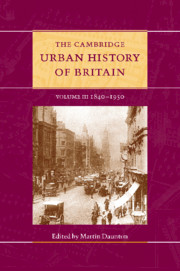Book contents
- Frontmatter
- 1 Introduction
- Part I Circulation
- 2 Urban networks
- 3 Modern London
- 4 Ports
- 5 The development of small towns in Britain
- 6 Migration
- 7 Pollution in the city
- 8 From Shillibeer to Buchanan: transport and the urban environment
- Part II Governance
- Part III Construction
- Part IV Getting and spending
- Part V Images
- Select bibliography
- Index
- Plates 1-7
- Plates 8-14
- Plates 15-20
- Plates 21-27
- Plates 28-34
- Plates 35-41
- Plates 42-48>
- Plates 49-53
- References
3 - Modern London
from Part I - Circulation
Published online by Cambridge University Press: 28 March 2008
- Frontmatter
- 1 Introduction
- Part I Circulation
- 2 Urban networks
- 3 Modern London
- 4 Ports
- 5 The development of small towns in Britain
- 6 Migration
- 7 Pollution in the city
- 8 From Shillibeer to Buchanan: transport and the urban environment
- Part II Governance
- Part III Construction
- Part IV Getting and spending
- Part V Images
- Select bibliography
- Index
- Plates 1-7
- Plates 8-14
- Plates 15-20
- Plates 21-27
- Plates 28-34
- Plates 35-41
- Plates 42-48>
- Plates 49-53
- References
Summary
It is difficult to speak adequately or justly of London. It is not a pleasant place; it is not agreeable, or cheerful, or easy, or exempt from reproach. It is only magnificent. You can draw up a tremendous list of reasons why it should be insupportable …But …for one who takes it as I take it, London is on the whole the most possible form of life …It is the biggest aggregation of human life – the most complete compendium of the world. The human race is better represented there than anywhere else, and if you learn to know your London you learn a great many things.
Henry James, 18811Distilling the essence of modern London into a chapter, one cannot help but be selective. I will focus on just four, interrelated aspects of London’s history: government, social geography, economy and Empire. It is clearly impossible to understand London without examining the ‘problem’ of London’s government: the relationship between central government, the Corporation of the City, London-wide authorities such as the Metropolitan Board of Works and its successor, the London County Council, and lower-tier authorities, initially parish vestries and district boards and, subse-quently, metropolitan borough councils. But making sense of debates about appropriate forms of metropolitan government demands a sensitivity to London’s changing social geography: a nineteenth-century contrast between poor East End and rich West End, subsumed in a twentieth-century contrast between working-class inner and middle-class outer London. Of course there are numerous qualifications to be made to this caricature, to take account of working-class suburbanisation, the survival of an elite West End and, more recently, a sporadic gentrification of inner London, and a City that shifted from mixed residential to almost exclusively non-residential in its pattern of land use.
Keywords
- Type
- Chapter
- Information
- The Cambridge Urban History of Britain , pp. 95 - 132Publisher: Cambridge University PressPrint publication year: 2001
References
- 2
- Cited by



